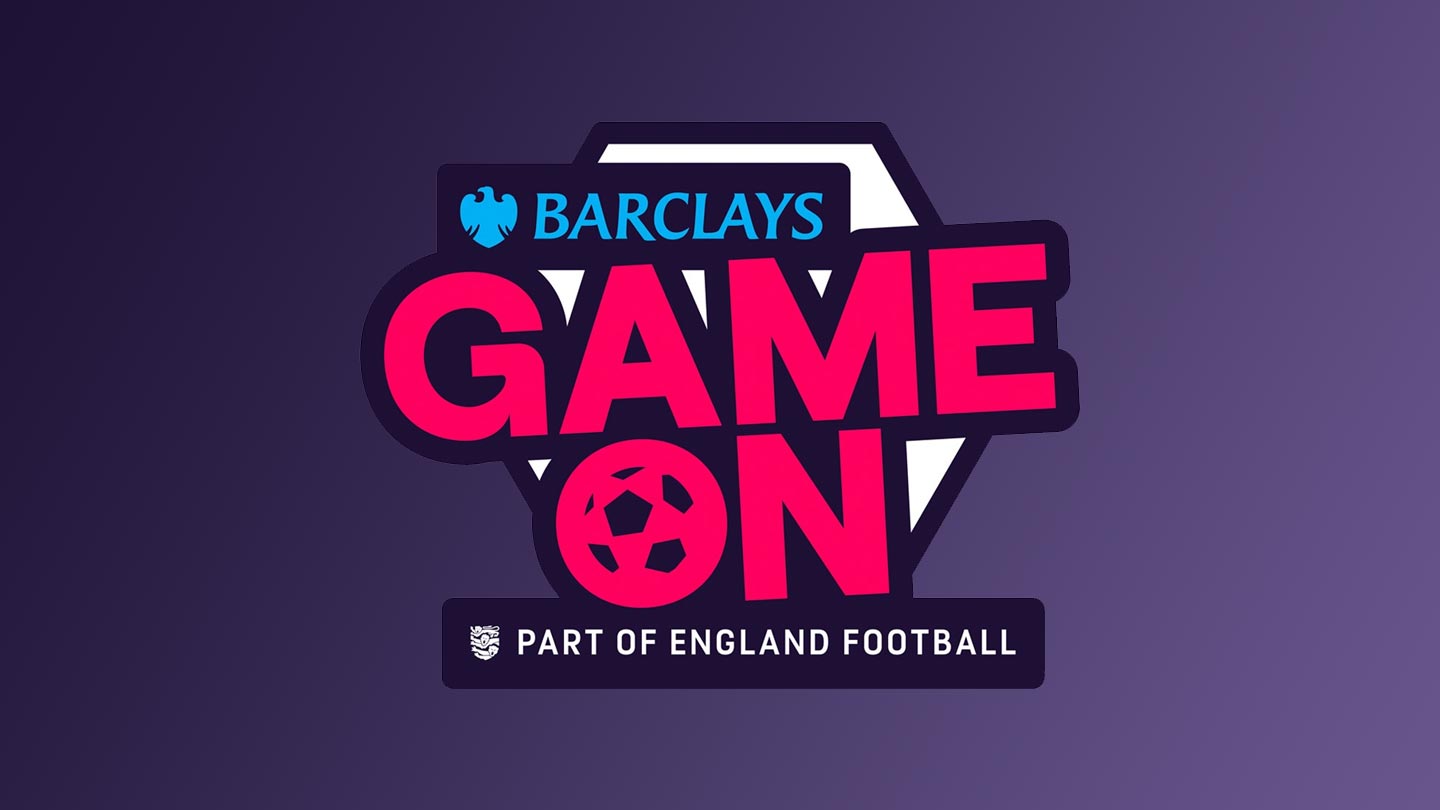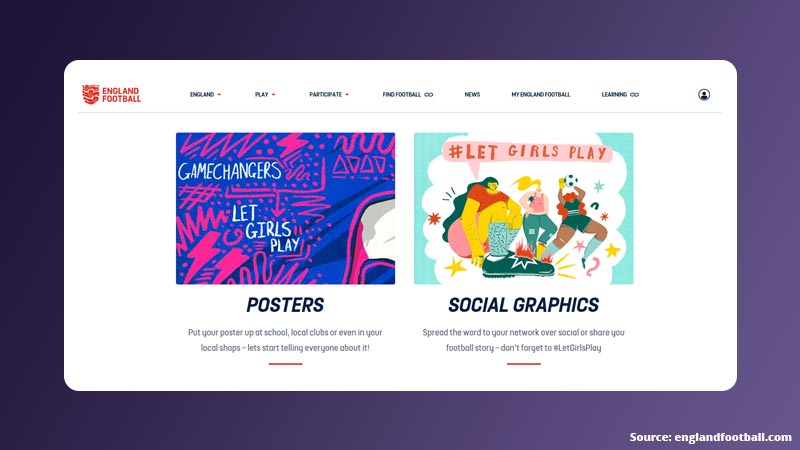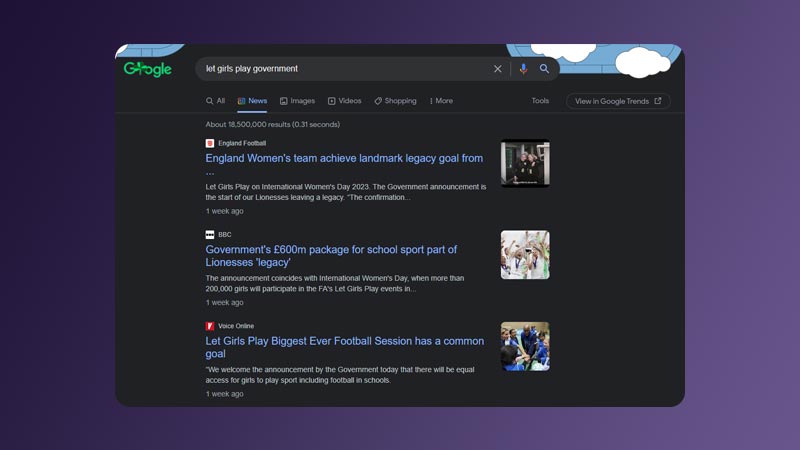Girls should have the same access to football in schools and clubs as boys do. Should being the operative word there. Unfortunately, in 2023, they don’t. But the tide is turning. And that’s thanks to the rise of women’s football in the UK, the Lionesses grabbing the attention and basically not letting it go.
#Letgirlsplay is the ‘not letting go’ campaign. The ultimate aim is for girls to have the same access to football as boys by 2024. But what is #Letgirlsplay exactly? How did it go down? And will it actually be effective?
I’ve tried to answer those questions, from a content standpoint, in the following few paragraphs. I love the campaign, I love the depth, and I love this Abby Wambach quote, which for me, sums it all up…
I have never once dribbled the whole field and scored a goal by myself.
— Abby Wambach
What is #Letgirlsplay?
A campaign created by England Football, backed by partners sharing the same purpose, endorsed by professionals, and delivered in schools and the community. A real strategic, concerted effort, driven both on- and offline.
The ultimate mission is simple, to get girls equal access to football by 2024. To give them the opportunity to try the sport. And fall in love it.
The campaign kicked off after the Lionesses 2022 Euro’s win, deliberately created to use the positive sentiment and enthusiasm felt by girls across the country. Similar to what happened after London 2012 with a number of sports.
#Letgirlsplay can be seen across social media encouraging girls to get involved, lobbying government, working with partners to sponsor grassroots football events, and providing resources for parents and teachers.
Five key content players of this campaign
I mentioned I loved #Letgirlsplay. That’s not just because of the message; it’s because the content strategy was so coordinated, with touchpoints everywhere, both online and off. I narrowed it down to five elements that I felt really stood out and made an impact…
1. Establish partnerships with a shared purpose
If you have a campaign or message you want to get shared, doing it on your own is a whole lot harder than going in with another brand. Two audiences are better than one, right? Three audiences are better than two!
For #Letgirlsplay, England Football made sure they had like-minded partners ready to go.
I emphasised like-minded there because sponsorship/partnership deals need to share similar desires and goals. That’s how you convey authenticity. The last thing you want is the message being diluted or criticised because of a lack of relevancy or controversy, it can damage both brands and distract the audience (See British Cycling and Shell).
For England Football, Weetabix and Barclays are two of the key players. Both have their own branded projects within the campaign, all laddering up to the ultimate goal of improving access for girls:
- Weetabix Wildcats is non-competitive football for girls, providing a great introduction to the sport.
- Barclays Game-On is about teaching life skills to girls through football at secondary schools.

2. Find influencers and allies to broadcast the message
We all know the power of influencers. Just how powerful they are really depends on what you’re asking them to do. Selling a product that isn’t relevant to their audience? Yeah, that won’t work. But sharing a message or increasing awareness for a purpose close to their audiences’ hearts? That’s where England Football nailed it for #Letgirlsplay.
The list of accounts sharing the message included:
- WSL and PL clubs – Teams across the Women’s Super League distributed the message across their digital channels, including this open letter from Arsenal and England’s Lotte Wubben-Moy.
- Ex- and current professionals – Beth Mead, Ellen White, and Queen of the Jungle Jill Scott were all at 10 Downing Street broadcasting and campaigning to #Letgirlsplay.
- Ian Wright – The work Wrighty does for the women’s game is inspiring. Constantly seen at Arsenal fixtures, always tweeting support, and many a viral video of him celebrating the Lionesses’ successes. He shared videos of his involvement.
We always come back to it, but relevancy is key yet again. Look at the accounts that have shared the message – footballers/teams who have a vested interest. As such, the majority of their followers would too, yet might not have been exposed to the campaign. And that’s how you gain traction. More like-minded people see it, more like-minded people share it, and the snowball’s momentum becomes unstoppable.

3. Timing is essential
The #Letgirlsplay campaign may be a long-term movement, a continuous message, but eventually you need the big splash to really draw people in. To make sure the message doesn’t become stagnant or forgotten.
England Football’s splash is the Let Girls Play Biggest Ever Football Session. An annual event organised with hundreds of primary and secondary schools. The event was huge in the relevant circles, but how do you get even more exposure? England Football took a risk. They chose a momentous day to coincide with the event, International Women’s Day.
In a lot of cases, you probably wouldn’t want to pick the same day as something so iconic. There’s the risk of your message being ignored, social media feeds being overcrowded. But when your message fits the narrative, there’s a piggybacking opportunity just waiting to be exploited.
England Football took a chance and ultimately were able to control the narrative and create conversation. When you come to point 5, you’ll see just how they did it.

4. Make it easy to share
Having a hashtag is a good start, but how else are you going to get people sharing your message? A lot of brands call it quits with a few social posts and a hashtag, hoping it sticks, but there’s so much more that can be done. Think images and resources, downloadable packs. Be proactive. Encourage the use of them. Do the heavy lifting so the only effort others have to make is to share rather than create.
This is something England Football did. They’ve got posters to put up, social graphics to download, and a pre-written letter for parents to send to their daughter’s schools asking for them to get involved.
I appreciated all of the above, but the feature that really stood out for me is the dedicated resource area for teachers. Teachers have no free time, like, not even enough to do their day jobs. Expecting them to then create extra lessons or put on afterschool clubs isn’t fair. England Football removed the obstacle. Again, the heavy lifting.
You can take a look at the resources here. They cover Key Stage 1,2,3 and 4, and have case studies and programmes for teachers to dive into as well. It’s a great initiative that I know first hand would be welcomed by anyone in primary or secondary education.

5. Earn some recognition with PR and the media
You can use your own social media and digital channels to share your message. You can lean on partners. Influencers. But don’t stop there. If you have a story to tell, use the media.
England Football didn’t just have the biggest ever football session for girls. Working with the government and using the success of #Letgirlsplay, they announced a new standard for equal access to sports in schools.
A perfectly timed press release, picked up by national outlets like the Guardian, the Independent, and The Athletic, as well as the regional papers across the country. It was earned. And it made sure the ultimate message of ‘getting equal access for girls’ made it into homes.
The announcement could’ve worked on its own, but combined with the already powerful collection of material, International Women’s Day became a girls’ sport onslaught.

So has it worked? Is #Letgirlsplay a success?
The campaign is running through until 2024, but for now, I’ll let the following tweet act as an answer for that…
2️⃣8️⃣5️⃣,0️⃣0️⃣0️⃣
— England Football (@EnglandFootball) March 8, 2023
An incredible turnout for this year’s #LetGirlsPlay Biggest Ever Football Session, more than enough to fill @wembleystadium 3 times over 🏟🏟🏟
A huge thank you to everyone who took part! 👐 pic.twitter.com/h3jfV94zMv


